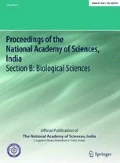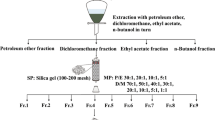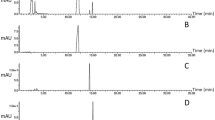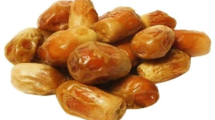Abstract
Hepatocellular carcinoma (HCC) stands second among deaths due to cancer. Although chemotherapeutic agents are being tried by clinicians to extend the survival rate of HCC patients, patient longevity is restricted because of the detrimental side effects of chemotherapeutic drugs. Rosmarinic acid (Ra), a natural phenolic compound, possesses numerous biological properties including antioxidant, anti-inflammatory, anti-angiogenic, anti-fibrosis, hepatoprotective and anticancer activities. Rosmarinic acid fraction isolated from Mentha arvensis extract (RaMa) was subjected to study the molecular mechanism of anticancer activity in vitro. HPLC analysis of RaMa has conferred an appreciable amount of Ra present in the extract. Apart from the antioxidant and antibacterial activity, RaMa induced dose-dependent cell death in cultured HepG2 (human hepatocellular carcinoma) cells with an LD50 of 27.622 µg mL−1 and was found to induce apoptosis. Fluorescence-activated cell sorting (FACS) analysis has shown distinct cell cycle arrest at Go/G1 phase in cells treated with RaMa and mRNA expression studies affirmed downregulation of the anti-apoptotic gene, Bcl-2 along with upregulation of pro-apoptotic genes Bax and ERK2 by Ra administration.
Graphic Abstract








Similar content being viewed by others
References
Tutusaus A, Stefanovic M, Boix L, Cucarull B, Zamora A, Blasco L et al (2018) Antiapoptotic BCL-2 proteins determine sorafenib/regorafenib resistance and BH3-mimetic efficacy in hepatocellular carcinoma. Oncotarget 9(24). http://www.oncotarget.com/fulltext/24673
Sim H-W, Knox J (2018) Hepatocellular carcinoma in the era of immunotherapy. Curr Probl Cancer 42(1):40–48. https://doi.org/10.1016/j.currproblcancer.2017.10.007
Ting C-T, Li W-C, Chen C-Y, Tsai T-H (2015) Preventive and therapeutic role of traditional Chinese herbal medicine in hepatocellular carcinoma. J Chin Med Assoc 78(3):139–144. https://doi.org/10.1016/j.jcma.2014.09.003
Wojdylo A, Oszmianski J, Czemerys R (2007) Antioxidant activity and phenolic compounds in 32 selected herbs. Food Chem 105(3):940–949. https://doi.org/10.1016/j.foodchem.2007.04.038
Hu Y, Wang S, Wu X et al (2013) Chinese herbal medicine-derived compounds for cancer therapy: a focus on hepatocellular carcinoma. J Ethnopharmacol 149(3):601–612. https://doi.org/10.1016/j.jep.2013.07.030
Cao W, Hu C, Wu L, Xu L, Jiang W (2016) Rosmarinic acid inhibits inflammation and angiogenesis of hepatocellular carcinoma by suppression of NF-κB signaling in H22 tumor-bearing mice. J Pharmacol Sci 132(2):131–137. https://doi.org/10.1016/j.jphs.2016.09.003
Yang S-Y, Hong C-O, Lee GP, Kim C-T, Lee K-W (2013) The hepatoprotection of caffeic acid and rosmarinic acid, major compounds of Perilla frutescens, against t-BHP-induced oxidative liver damage. Food Chem Toxicol 55:92–99. https://doi.org/10.1016/j.fct.2012.12.042
Chu X, Ci X, He J et al (2012) Effects of a natural prolyl oligopeptidase inhibitor, rosmarinic acid, on lipopolysaccharide-induced acute lung injury in mice. Molecules 17(3):3586–3598. https://doi.org/10.3390/molecules17033586
Li G-S, Jiang W-L, Tian J-W, Qu G-W, Zhu H-B, Fu F-H (2010) In vitro and in vivo antifibrotic effects of rosmarinic acid on experimental liver fibrosis. Phytomedicine 17(3–4):282–288. https://doi.org/10.1016/j.phymed.2009.05.002
Petersen M (2003) Rosmarinic acid. Phytochemistry 62(2):121–125. https://doi.org/10.1016/S0031-9422(02)00513-7
Hasanein P, Sharifi M (2017) Effects of rosmarinic acid on acetaminophen-induced hepatotoxicity in male Wistar rats. Pharm Biol 55(1):1809–1816. https://doi.org/10.1080/13880209.2017.1331248
Bakhshi A, Jensen JP, Goldman P et al (1985) Cloning the chromosomal breakpoint of t (14; 18) human lymphomas: clustering around Jh on chromosome 14 and near a transcriptional unit on 18. Cell 41(3):899–906. https://doi.org/10.1016/S0092-8674(85)80070-2
Youle RJ, Strasser A (2008) The BCL-2 protein family: opposing activities that mediate cell death. Nat Rev Mol Cell Biol 9(1):47–59. https://doi.org/10.1038/nrm2308
Reed JC (1997) Bcl-2 family proteins: regulators of apoptosis and chemoresistance in haematologic malignancies. Semin Haematol 34:9–19
Zhou K, Luo X, Wang Y, Cao D, Sun G (2017) MicroRNA-30a suppresses tumor progression by blocking Ras/Raf/MEK/ERK signalling pathway in hepatocellular carcinoma. Biomed Pharmacother 93:1025–1032. https://doi.org/10.1016/j.biopha.2017.07.029
Vitasari CR, Gramblička M, Gibcus K, Visser TJ, Geertman R, Schuur B (2015) Separating closely resembling steroids with ionic liquids in liquid–liquid extraction systems. Sep Purif Technol 155:58–65. https://doi.org/10.1016/j.seppur.2015.04.002
Siddiqui A, Ali M (1997) Practical pharmaceutical chemistry, 1st edn. CBS Publishers and Distributors, New Delhi, pp 126–131
Trease GE (1989) Trease and Evans pharmacognosy: a physician’s guide to herbal medicine, vol 13. Bailliere Tindall, London, p 912
Sithara NV, Komathi S, Rajalakshmi S, Queen J, Bharathi D (2016) Phytochemical analysis of Andrographis paniculata using different solvents. Eur J Biotechnol Biosci 4(8):28–30
Mary NK, Shylesh BS, Babu BH, Padikkala J (2002) Antioxidant and hypolipidaemic activity of a herbal formulation. Liposem Ind J Exp Biol 40:901–904
Sreejayan Rao MNA (1997) Nitric oxide scavenging by curcuminoids. J Pharm Pharmacol 49:105–107
Mosmann T (1982) Rapid Calorimetric assay for cellular growth and survival: application to proliferative and cytotoxic assays. J Immunol Methods 65:55–63
Kasibhatla S (2006) Acridine orange/ethidium bromide (AO/EB) staining to detect apoptosis. Cold Spring Harb Protoc 2006(21):pdb.prot4493. https://doi.org/10.1101/pdb.prot4493
Bennet CA, Franklin NL (1967) Statistical analysis in chemistry and chemical industry. Wiley, New York, p 133
Adomako-Bonsu AG, Chan SL, Pratten M, Fry JR (2017) Antioxidant activity of rosmarinic acid and its principal metabolites in chemical and cellular systems: importance of physico-chemical characteristics. Toxicol In Vitro 40:248–255. https://doi.org/10.1016/j.tiv.2017.01.016
Rajesh K, Swamy AH, Inamdar SS, Joshi V, Kurnool AN (2013) Hepatoprotective and antioxidant activity of ethanol extract of Mentha arvensis leaves against carbon tetrachloride induced hepatic damage in rats. Int J Pharm Tech Res 5:426–430
Sánchez-Camargo AP, Mendiola JA, Valdés A et al (2016) Supercritical antisolvent fractionation of rosemary extracts obtained by pressurized liquid extraction to enhance their antiproliferative activity. J Supercrit Fluids 107:581–589. https://doi.org/10.1016/j.supflu.2015.07.019
Anusuya C, Manoharan S (2011) Antitumor initiating potential of rosmarinic acid in 7, 12-dimethylbenz (a) anthracene-induced hamster buccal pouch carcinogenesis. J Environ Pathol Toxicol Oncol 30:199–211
Fattahi M, Nazeri V, Torras-Claveria L et al (2013) A new biotechnological source of rosmarinic acid and surface flavonoids: hairy root cultures of Dracocephalum kotschyi Boiss. Ind Crops Prod 50:256–263. https://doi.org/10.1016/j.indcrop.2013.07.029
Biswas NN, Saha S, Ali MK (2014) Antioxidant, antimicrobial, cytotoxic and analgesic activities of ethanolic extract of Mentha arvensis L. Asian Pac J Trop Biomed 4(10):792–797. https://doi.org/10.12980/APJTB.4.2014C1298
Özgen U, Mavi A, Terzi Z et al (2010) Relationship between chemical structure and antioxidant activity of luteolin and its glycosides isolated from Thymus sipyleus subsp. sipyleus var. sipyleus. Planta Med. https://doi.org/10.1055/s-0030-1264257
Asghari B, Mafakheri S, Zarrabi MM, Erdem SA, Orhan IE, Bahadori MB (2018) Therapeutic target enzymes inhibitory potential, antioxidant activity, and rosmarinic acid content of Echium amoenum. South Afr J Bot. https://doi.org/10.1016/j.sajb.2018.05.017
Wang H (2004) Determination of rosmarinic acid and caffeic acid in aromatic herbs by HPLC. Food Chem 87(2):307–311. https://doi.org/10.1016/j.foodchem.2003.12.029
Sosa V, Moliné T, Somoza R, Paciucci R, Kondoh H, LLeonart ME (2013) Oxidative stress and cancer: an overview. Ageing Res Rev 12(1):376–390. https://doi.org/10.1016/j.arr.2012.10.004
Pascua-Maestro R, Corraliza-Gomez M, Diez-Hermano S, Perez-Segurado C, Ganfornina MD, Sanchez D (2018) The MTT-formazan assay: complementary technical approaches and in vivo validation in Drosophila larvae. Acta Histochem 120(3):179–186. https://doi.org/10.1016/j.acthis.2018.01.006
Domitrović R, Potočnjak I, Crnčević-Orlić Ž, Škoda M (2014) Nephroprotective activities of rosmarinic acid against cisplatin-induced kidney injury in mice. Food Chem Toxicol 66:321–328. https://doi.org/10.1016/j.fct.2014.02.002
Han Y-H, Kee J-Y, Hong S-H (2018) Rosmarinic acid activates AMPK to inhibit metastasis of colorectal cancer. Front Pharmacol 9:68. https://doi.org/10.3389/fphar.2018.00068
Soderquist RS, Eastman A (2016) BCL2 inhibitors as anticancer drugs: a plethora of misleading BH3 mimetics. Mol Cancer Ther 15(9):2011–2017. https://doi.org/10.1158/1535-7163.MCT-16-0031
Liu Z, Ding Y, Ye N, Wild C, Chen H, Zhou J (2016) Direct activation of bax protein for cancer therapy. Med Res Rev 36(2):313–341. https://doi.org/10.1002/med.21379
Dhillon AS, Hagan S, Rath O, Kolch W (2007) MAP kinase signalling pathways in cancer. Oncogene 26:3279–3290
Randhawa H, Kibble K, Zeng H, Moyer M, Reindl K (2013) Activation of ERK signaling and induction of colon cancer cell death by piperlongumine. Toxicol Vitro 27(6):1626–1633. https://doi.org/10.1016/j.tiv.2013.04.006
Acknowledgements
The authors are thankful to all the staff in Biogenix Research Center for Molecular Biology and Applied Sciences for their assistance to undertake the work.
Author information
Authors and Affiliations
Corresponding author
Ethics declarations
Conflict of interest
There is no conflict of interest to disclose.
Additional information
Publisher's Note
Springer Nature remains neutral with regard to jurisdictional claims in published maps and institutional affiliations.
Significance Statement Rosmarinic acid specifically isolated and purified from M. arvensis was evaluated for its inhibition on growth and proliferation of liver cancer which is not reported previously. Go/G1 phase arrest induced by RA can be attributed as synchronization of Bcl2-induced apoptosis.
Rights and permissions
About this article
Cite this article
Jerard, C., Michael, B.P., Chenicheri, S. et al. Rosmarinic Acid-Rich Fraction from Mentha arvensis Synchronizes Bcl/Bax Expression and Induces Go/G1 Arrest in Hepatocarcinoma Cells. Proc. Natl. Acad. Sci., India, Sect. B Biol. Sci. 90, 515–522 (2020). https://doi.org/10.1007/s40011-019-01122-9
Received:
Revised:
Accepted:
Published:
Issue Date:
DOI: https://doi.org/10.1007/s40011-019-01122-9




